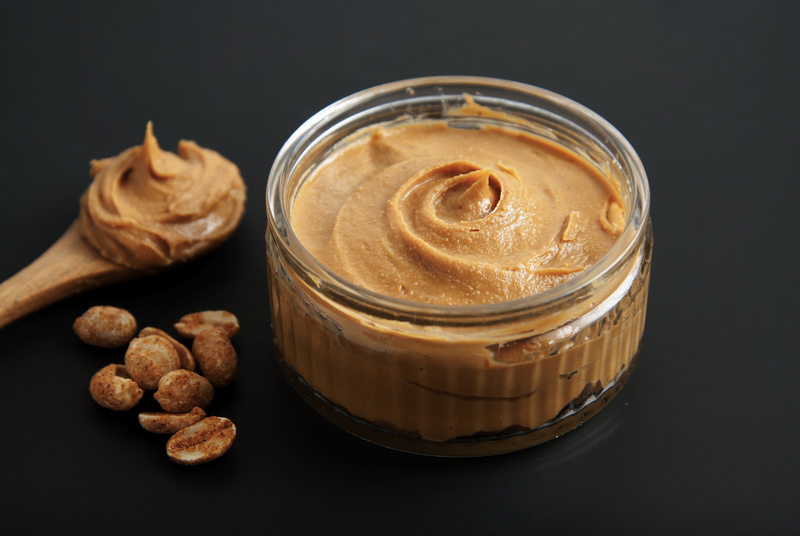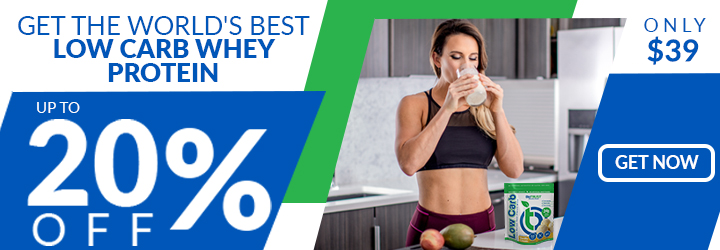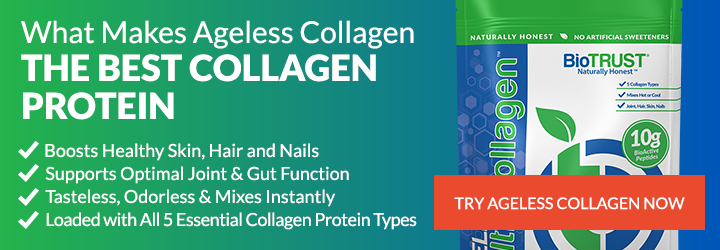Is Peanut Butter ACTUALLY Good for You? Here are the Facts

While “nut” is in the name, peanuts are technically legumes. As opposed to nuts like almonds and walnuts, which grow on trees, peanuts grow underground, which explains why peanuts are often referred to as ground nuts, gouber peas, ground peas, pindar nuts, earth-nuts, ground beans, or even goobers. Regardless of what they’re called, in the United States, peanuts (and peanut butter) are by far the most popular “nut,” comprising 67% of all nut consumption.
But, is peanut butter good for you? But what do peanuts do to your body? Are they healthy? Are they fattening? Here’s the lowdown on this pseudo-nut.
Peanut Butter and Your Nutrition
A one-ounce (1/4 cup) serving of peanuts contains:
- Calories: 164
- Total Fat: 14 g
- Saturated Fat: 2 g
- Total Carbohydrate: 6 g
- Dietary Fiber: 2 g
- Sugars: 1 g
- Protein: 7 g
- Vitamins and minerals (% RDI):
- Copper: 0.42 mg (47%)
- Manganese: 0.71 mg (36%)
- Niacin: 4.4 mg (28%)
- Folate: 87.6 mcg (22%)
- Biotin: 6.4 mcg (21%)
- Vitamin E: 3.4 mg (20%)
- Phosphorus: 137 mg (20%)
- Thiamin: 0.23 mg (19%)
- Magnesium: 49 mg (12%)
- Zinc: 0.9 mg (6%)
- Choline: 15.5 mg
By definition, peanuts are technically a “good” source of protein, providing 10% of the Reference Daily Intake (RDI) per serving (more than any other nut). However, research shows quite clearly and conclusively that the RDI for protein (64 grams per day) is far from optimal. In fact, 2 – 3 times that amount may be best for supporting overall health.
Beyond that, peanuts are not a “complete” source of protein, as they don’t contain all the essential amino acids (i.e., methionine). That doesn’t make peanuts “bad.” Rather, it’s not a great idea to rely on them for their protein content. After all, there are far more protein-dense, higher quality sources of protein.
With 77% of calories coming from fat, peanuts are a high-fat, calorie-dense food. Fifty percent of the fat in peanuts is of the monounsaturated variety, while 32% is polyunsaturated fats, nearly all of which are omega-6 fatty acids. Hang onto that, as we’ll be coming back to it shortly.
Is Peanut Butter Good For You? Here Are the Drawbacks
So when it comes to the question “Is peanut butter good for you?”, let’s start with the negatives first.
1. Peanut Butter—Not Just Peanuts
If you’ve ever taken time to review the ingredients and nutrition information on the various containers of peanut butter, you already know that, while mostly peanuts, peanut butter can contain much more than that. Of course, there are a few brands that only contain peanuts, but those are few and far between.
Most peanut butter, particularly the popular brands, contain peanuts along with the addition of sugar, fat, and salt. This is critical to highlight. No, it’s not that the amount of added sugar is going to make you fat. No, it’s not that the amount of salt is necessarily a threat to cardiovascular wellness. No, it’s not that the amount of added poor-quality fat is enough to ravage your health (unless it’s partially hydrogenated oil).
Rather, it’s because this trio of ingredients, provided in precise amounts, known as the “three pillars of processed foods.”8 In his book Sugar Salt Fat: How the Food Giants Hooked Us, Pulitzer Prize-winning investigative journalist for the New York Times Michael Moss discusses how food manufacturers rely on salt, sugar, and fat to “override our dietary self-control” through foods “so perfectly engineered to compel overconsumption.”
Ask yourself this: Have you ever found that it’s incredibly difficult to limit portion sizes when it comes to peanut butter? Better said, have you ever found that it’s incredibly easy to overeat peanut butter? You wouldn’t be alone if you said that you’re the type of person who’s been known to eat a half jar (or even an entire jar)…and still want more.
What you may not have realized is that most commercial peanut butter has the very same qualities as potato chips, pizza, French fries, and chocolate, which are commonly regarded as the most “addictive” foods.10
With sugar and fat intake, brain pleasure centers light up in functional magnetic resonance imaging studies—just as they would with an addictive drug. Increasing the amount of sugar intake leads to a “bliss point” of maximum taste satisfaction, disposing you to crave sugar in a virtual addiction, Moss describes.
Moss stresses that “fat is an energy colossus. It packs 9 calories into each gram, more than twice the caloric load of either sugar or protein.” For fat, instead of a “bliss point,” there is a quite potent “mouthfeel” (dryness, gumminess, and moisture release) to make foods more enjoyable. 9
When it comes to salt, says Moss, the food processing industry is completely hooked. It’s a “miracle” ingredient that solves all their problems. On one hand, salt provides a flavor burst. On the other hand, it is a preservative so “foods” can stay on the shelves for months. It also has the capability to mask “off-notes” in flavors that are not inherent to processed foods. Like sugar, salt has “addictive qualities.” 8
Bottom line is this: If you’re going to choose peanut butter, your best bet is to choose natural peanut butter with the only ingredient being peanuts—NO added sugar, salt, or fat.
2. Peanut Butter and Omega-6 Fats
As mentioned above, about 32% of the fat in peanuts are polyunsaturated fats, nearly all of which are omega-6 fatty acids. For instance, a one-ounce serving of peanuts contains about 4,400 mg of omega-6 fatty acids. On the flipside, the same serving provides less than 1 mg of omega-3 fatty acids. If you’re keeping score, that’s a 4,400 to 1 ratio of omega-6 to omega-3 fats.
Why is that important? Experts estimate that throughout human history, the optimal ratio for consumption of omega-6 fatty acids (e.g., linoleic acid) to omega-3 fatty acids (e.g., alpha-linolenic acid, DHA, EPA) was about 1:1. With the contemporary diet, this ratio has shifted dramatically in favor of omega-6 fatty acids to 20:1.11
This is important for a number of reasons. For instance, these omega-6 fats compete with omega-3 fats for “parking spots” within the cell membranes of the body.12 It’s this dramatic increase in linoleic acid (a type of omega-6 fat) that has led to corresponding decreases of key omega-3 fats EPA and DHA. Along those lines, take a look at the laundry list of benefits associated with these two essential omega-3 fatty acids (that you’re missing out on by overconsuming omega-6-rich oils):
- DHA (and to a lesser extent, EPA) is effective at reducing blood triglycerides. 13
- DHA may have a profound anti-inflammatory effect. 14
- DHA may have a favorable effect on HDL particle size, and DHA increases HDL-C (i.e., “good” cholesterol) levels. 13,15
- DHA is present in ALL organs, and it is the predominant omega-3 fatty acid found in the brain and retinal tissue. 12, 16
- DHA has been shown to accumulate in areas of the brain involved in memory and attention such as the cerebral cortex and hippocampus, and DHA has been specifically found to improve both memory and reaction time. 17,18
- EPA (and to a lesser extent, DHA) reduces blood levels of Arachidonic Acid (AA), which is the primary mediator of cellular inflammation. 12, 19
- The ability of EPA to increase the EPA/AA may play a role in cardiovascular health. A recent study found that higher blood levels of EPA were associated with lower incidence of major coronary events. 20
- EPA levels may be closely correlated with mood disorders, and controlled human trials have shown a benefit with EPA
supplementation. 21 - EPA may also boost the effectiveness of standard anti-depressant medications while reducing associated insomnia and tempering the aggression associated with some conditions. 22
Balancing these essential fats is also very important when it comes to promoting a healthy inflammatory response. For example, omega-3 fatty acids have anti-inflammatory effects whereas omega-6 fatty acids do not. 23 Even more, studies show that omega-6 fats promote inflammation, particularly when they are consumed in excess of omega-3 fats. 24
Researchers attribute this imbalanced intake of omega fats to an increase in virtually all inflammation-related conditions including cardiovascular disease, diabetes, obesity, metabolic syndrome, irritable bowel syndrome, inflammatory bowel disease, rheumatoid arthritis, asthma, mood disorders, mental illness, autoimmune disease, accelerated aging, and more. 25
3. Peanut Butter and Aflatoxins
Generally speaking, peanuts can be considered quite healthy. However, peanuts tend to be one of the greatest dietary sources of aflatoxins, a type of mycotoxin, which are toxic or carcinogenic secondary metabolites produced by fungi that infect foods such as peanuts, corn, and grains. In other words, fungi such as Aspergillus flavus and Aspergillus parasiticus colonize peanut plants and produce these toxic compounds. 26
In the short-term, humans are relatively resistant to the effects of aflatoxins. However, what happens with long-term exposure is uncertain at this point. Some human studies have shown that aflatoxins may cause adverse immune system effects, liver cancer, and stunted growth in children. Having said that, one study showed an 89% reduction in aflatoxin concentration during the production of peanut butter. 27
Further, the United States Department of Agriculture (USDA) has strict requirements and stringent testing for aflatoxins in the food supply.
Is Peanut Butter Actually Good For You? Here Are the Positives
We have established the downsides of peanut butter. But let’s show you the positives to the question “Is Peanut Butter Good For You?”
1. Peanuts Loaded with Antioxidants
There’s more to this legumes story than can be found above. Believe it or not, peanuts contain the antioxidant resveratrol, which is commonly associated with red wine and the skin of red grapes.1 Resveratrol, which belongs to a category of polyphenols called stilbenoids, is produced by the peanut plant when exposed to stress (e.g., infected by a microbial pathogen). Peanut stilbenoids have been considered the major sustaining factor of the plant’s resistance to disease.2
The health benefits of resveratrol may be many and have been well-established. A number of studies have demonstrated the anti-inflammatory activity of resveratrol and its ability to promote a healthy inflammatory response.3
Research has also shown that resveratrol decreases the synthesis of fat and reduces the uptake of fat by fat cells and increases the body’s ability to burn fat for fuel (in the muscles and liver).4
Interestingly, it’s also been shown to “brown” white adipose tissue (i.e., body fat). It seems to increase metabolic rate and calorie expenditure via activation of brown adipose tissue (BAT) thermogenesis. Simply put, BAT is unique in that it burns body fat to produce heat.5,6
It may also come as a surprise that peanuts have a higher polyphenol (a category of plant-based antioxidants) content than almonds, Brazil nuts, cashews, macadamia nuts, and pine nuts. What’s more, peanuts have a higher total antioxidant capacity than Brazil nuts, cashews, macadamias, and pine nuts.7
2. Peanut Butter Can Boost Appetite Control
Studies have consistently shown that nut intake moderates appetite after consumption. Specifically, well-controlled human trials have shown that eating almonds and peanuts suppresses hunger and desire to eat and increases fullness. Studies have shown that as little as four days of including peanuts increases feelings of satisfaction and levels of fullness. 28
These are very important qualities when it comes to weight management. Reducing hunger can help increase the duration between meals. Meanwhile, a decreased desire to eat can help prevent eating when not truly hungry. On top of that, greater levels of satiety (feelings of fullness and satisfaction) may lead to smaller meal sizes.
Many people shy away from nuts because they are calorie-dense. Interestingly, studies show that nut intake results in a strong compensatory dietary response. In other words, people tend to “compensate” by eating fewer calories in subsequent meals. Although the numbers vary, it’s suggested that the majority of calories provided by nuts are offset by spontaneous adjustments in one’s complete diet. 28 Somewhat surprisingly, one study showed that peanut butter resulted in greater dietary compensation than whole peanuts, despite a weaker satiety effect. 29,30
In one study, participants who were instructed to add peanuts to their diet compensated for 66% of the calories provided by nuts. What’s more, the amount of weight gained was substantially lower (over 3 times lower) than what would have been expected. 31
3. Peanut Butter and Weight Management
Overall, research shows that nut consumption (including peanut consumption) is consistently associated with lower body weight. Not only that, adherence to moderate- and high-fat weight-loss diets compared to low-fat weight-loss diets is better. Along those lines, the nutrient profile of moderate-fat diets tends to be superior. 32
In a study published in the Journal of the American College of Nutrition, researchers found that peanut intake was associated with a significantly lower body mass index (BMI), a ratio of weight to height that is used as an indicator of health, in women with a similar trend in men. 33
Interestingly, when total calorie intake is not controlled, studies that add nuts to the normal diets of free-living folks have shown that nut consumption does not lead to weight gain. Even more, several studies assessing the role of nut consumption in weight-maintenance programs have resulted in a decrease in body weight. 28
While peanuts and tree nuts are commonly regarded as high-fat, calorie-dense foods, what many don’t recognize is that the body does not efficiently absorb all the fat and energy provided by them. A number of studies have looked at this phenomenon, and all showed substantial increases in the body’s excretion of fat (and calories). For instance, one trial showed that 17.8% and 7% of the fat from whole peanuts and peanut butter, respectively, was excreted. 34
4. Peanut Butter Can Help Promote Heart Health
In the Nurses’ Health Study, researchers subdivided nut intake between all tree nuts and peanuts and peanut butter. Consumption of peanut products was associated with a decreased relative risk of coronary heart disease (CHD). 37 Participants who consumed peanuts two or more times per week had a relative risk of CHD of 0.66, while for other nuts the relative risk for consumption of two or more times per week was 0.79.
A recent report of the same study looking at a subgroup of women shows similar findings, as consumption of at least five servings per week of nuts or peanut butter was significantly associated with a lower risk of cardiovascular disease, with a relative risk of 0.56. 38 Research shows that moderate-fat diets that contain peanuts elicit a more favorable lipid profile after maintenance of weight loss compared to low-fat diets. 39
In a recent well-controlled 30-week intervention study, researchers examined the effects of peanut consumption on blood lipids in healthy adults. 40 They found that daily peanut consumption resulted in significant reductions in total cholesterol and triglycerides. Maintaining healthy levels of cholesterol and triglycerides are important variables for cardiovascular health. 41
According to Purdue researcher, Dr. Richard Mattes, “Peanuts are the most widely consumed nut in this country. They are a rich source of monounsaturated fatty acids, magnesium, folate, vitamin E, copper, arginine, and fiber, all of which have cardiovascular disease risk-reducing properties.”
In a study published in the Journal of the American College of Nutrition, Mattes found that regular peanut consumption “lowers blood triglycerides and augments consumption of nutrients associated with reduced cardiovascular risk.” 42
“Peanuts are often viewed as unhealthy because they are high in fat,” says Mattes. “But peanuts are rich in the types of fats that actually reduce cardiovascular disease risk and have strong satiety properties—meaning a person feels full after eating peanuts—so they do not pose a threat of weight gain. People can feel comfortable including them in their diets to take advantage of peanuts’ reducing the risk of heart disease, without adding to body weight. We have learned that regular peanut consumption lowers triglyceride levels by as much as 24%—even in the group where peanuts were added to regular dietary intake. We also saw no significant change in body weight, despite adding 500 calories of peanuts a day for eight weeks.”
Where did those calories go? According to research from Mattes and others, there are three potential answers:
- Peanuts have a high satiety value, and that feeling of being full reduces the amount a person eats.
- Peanuts trigger an increase in people’s resting metabolic rate.
- People don’t chew nuts well, so people’s bodies fail to absorb a portion of nuts’ caloric energy.
Is Peanut Butter Good For You? Moderation is Key
When I am asked “Is Peanut Butter Good For You”, I usually respond with “in moderation.”
Generally speaking, peanuts and peanut butter can be included as part of an overall healthy diet. Obviously, there are exceptions. For instance, peanut allergy is one of the most common food allergies, in which case peanuts can cause a severe, potentially fatal, reaction. It goes without saying that peanuts should be completely avoided in those cases.
For the overwhelming majority of folks, peanuts and peanut butter (along with tree nuts) may provide numerous health benefits. Having said that, peanuts are not synonymous with peanut butter. Most commercially-available peanut butter contains added sugar, salt, and fat. With that in mind, when choosing peanut butter, it’s best to opt for natural (preferably organic) peanut butter made only with peanuts and no other added ingredients.








